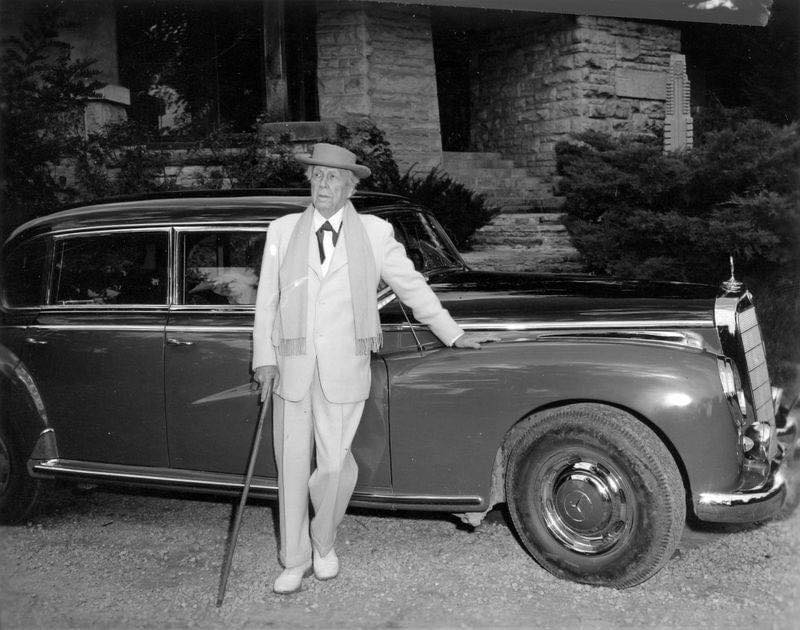Frank Lloyd Wright, the legendary American architect known for his groundbreaking designs and innovative approach to architecture, was not only a visionary in the realm of buildings but also had a discerning eye for automobiles. One notable vehicle in his collection was the 1955 Mercedes-Benz 300B sedan. This article delves into the story behind this automotive marvel and its connection to the brilliant mind of Frank Lloyd Wright.
A Confluence of Design Excellence
The 1955 Mercedes-Benz 300B sedan and Frank Lloyd Wright’s architectural masterpieces represent a remarkable convergence of design excellence. Both entities share a commitment to meticulous craftsmanship, attention to detail, and the pursuit of timeless elegance.
Frank Lloyd Wright, renowned for his organic architecture philosophy, believed in creating structures that harmonized with their natural surroundings. His designs were characterized by clean lines, integration of indoor and outdoor spaces, and a seamless flow between the built environment and nature. The Mercedes-Benz 300B, with its graceful contours, balanced proportions, and refined aesthetics, mirrored Wright’s architectural principles.
The 300B sedan, designed by Mercedes-Benz during the mid-1950s, showcased the brand’s commitment to luxury and innovation. The vehicle’s exterior design exuded a sense of understated elegance, with smooth curves and restrained use of ornamentation. Its aerodynamic silhouette, enhanced by the iconic Mercedes-Benz grille, conveyed a sense of sophistication and timelessness.
Inside the 300B, craftsmanship and attention to detail were paramount. The luxurious materials, meticulously tailored upholstery, and thoughtfully arranged controls created an environment of refined comfort. The cabin reflected the same commitment to quality and meticulous design that Wright infused into his architectural projects.
Both Wright’s architecture and the Mercedes-Benz 300B prioritized the integration of form and function. Wright’s buildings, like the Guggenheim Museum, Fallingwater, and the Robie House, were not merely structures but works of art that harmonized with their surroundings. Similarly, the 300B’s design was not solely about aesthetics but also about optimizing performance and aerodynamics.
Moreover, the 300B sedan exemplified the automotive advancements of its time, featuring a powerful engine, advanced suspension, and cutting-edge technology. These innovations resonated with Wright’s forward-thinking mindset and his inclination toward embracing technological progress.
Frank Lloyd Wright’s affinity for the 1955 Mercedes-Benz 300B sedan showcased his discerning eye for design, extending beyond the realm of architecture. It reflected his appreciation for beauty, craftsmanship, and the seamless integration of art and functionality. The harmonious convergence of Wright’s architectural principles and the exceptional design of the 300B sedan resulted in a union that embodied the pursuit of design excellence.
Today, the 1955 Mercedes-Benz 300B sedan stands as a testament to the enduring legacy of both Frank Lloyd Wright and the Mercedes-Benz brand. It serves as a reminder of their shared commitment to creating objects of beauty, timeless elegance, and impeccable craftsmanship. The confluence of design excellence between Wright and the 300B continues to inspire and captivate individuals who appreciate the harmonious marriage of art and engineering.
Wright’s Acquaintance with the Mercedes-Benz 300B
Frank Lloyd Wright’s acquaintance with the Mercedes-Benz 300B sedan is a fascinating aspect of his personal life and his connection to the world of automobiles. While specific details of how he came to acquire the car may be scarce, it is believed that Wright obtained the 1955 Mercedes-Benz 300B while he was involved in the iconic Guggenheim Museum project in New York City.
During this period, Wright’s reputation as a groundbreaking architect was reaching new heights, and his visionary designs were garnering international acclaim. It was a time of great creative energy for Wright, and his involvement with the Guggenheim Museum project solidified his status as an architectural icon.
It was during this bustling time that Wright’s passion for design extended beyond the realm of buildings to include automobiles. The acquisition of the Mercedes-Benz 300B sedan became a testament to his discerning taste and appreciation for refined luxury.
Wright’s attraction to the 300B sedan was likely influenced by the vehicle’s exceptional performance, elegant design, and reputation for quality. The 300B was part of Mercedes-Benz’s prestigious 300 series, renowned for its craftsmanship and advanced engineering. As an architect who paid meticulous attention to every detail, Wright could appreciate the meticulous craftsmanship and engineering excellence inherent in the 300B.
The Mercedes-Benz 300B sedan perfectly complemented Wright’s own design sensibilities. Its sleek lines, balanced proportions, and understated elegance resonated with his philosophy of organic architecture. Just as Wright sought to create buildings that seamlessly integrated with their natural surroundings, the 300B’s design embodied a similar sense of harmony between aesthetics and functionality.
Wright’s ownership of the 300B sedan showcased his desire to surround himself with objects that exemplified his artistic vision and appreciation for beauty. The vehicle became an extension of his personality and an embodiment of his refined taste, much like the architectural masterpieces he created.
The Mercedes-Benz 300B sedan’s association with Frank Lloyd Wright adds an intriguing layer to the history and legacy of the car. It underscores its status as a symbol of elegance and design excellence recognized and appreciated by individuals who valued artistic expression and exceptional craftsmanship.
Today, Wright’s acquaintance with the Mercedes-Benz 300B sedan serves as a testament to his multidimensional approach to design and his ability to recognize beauty and craftsmanship in various forms. It highlights the enduring appeal of the 300B and its ability to captivate the discerning eye of one of the world’s most influential architects.
The Design Legacy
The design legacy of the 1955 Mercedes-Benz 300B sedan extends far beyond its time and showcases the enduring influence it has had on the automotive industry. This iconic vehicle exemplifies the pinnacle of automotive design and craftsmanship, leaving a lasting impact on future generations of car manufacturers and enthusiasts alike.
The 300B sedan’s design legacy is characterized by its timeless elegance and harmonious proportions. Its sleek lines, gently curved fenders, and signature Mercedes-Benz grille have become synonymous with classic automotive design. The 300B’s aesthetic appeal has stood the test of time, remaining relevant and captivating even in the modern era.
One of the key contributions of the 300B to automotive design was its emphasis on aerodynamics. With its smooth contours and careful attention to airflow management, the 300B minimized drag and enhanced performance. This focus on aerodynamic efficiency set a precedent for subsequent generations of vehicles, influencing the design direction of many automakers in the years that followed.
Moreover, the Mercedes-Benz 300B sedan’s interior design exemplified luxury and sophistication. From the meticulously crafted upholstery to the polished wood accents and chrome detailing, every element exuded a sense of refinement and quality. The attention to detail and use of premium materials became benchmarks for luxury automotive interiors and continue to inspire designers to this day.
The influence of 300B’s design legacy can be observed in the subsequent models produced by Mercedes-Benz. The iconic grille design, the elegant silhouette, and the emphasis on meticulous craftsmanship have become hallmarks of the brand’s identity. Mercedes-Benz vehicles, across various model lines, continue to carry forward the legacy of the 300B, incorporating elements of its design language into their own iterations.
Beyond Mercedes-Benz, the design principles and cues established by the 300B have influenced the broader automotive industry. Many automakers have drawn inspiration from the classic elegance and attention to detail exhibited by the 300B, incorporating similar elements into their own designs. The legacy of the 300B can be seen in the pursuit of refined aesthetics, aerodynamic efficiency, and luxurious interiors in modern luxury and performance vehicles.
The enduring impact of the 300B’s design legacy extends beyond the automotive world. Its influence can be seen in other areas of design, such as furniture, architecture, and fashion. The harmonious balance of form and function, the commitment to quality craftsmanship, and the timeless elegance of the 300B continue to inspire designers across various disciplines.
In conclusion, the design legacy of the 1955 Mercedes-Benz 300B sedan is one of enduring influence and inspiration. Its timeless aesthetic, emphasis on aerodynamics and commitment to refined craftsmanship have left an indelible mark on the automotive industry. The legacy of the 300B is a testament to the enduring appeal of exceptional design and its ability to transcend time and captivate generations of enthusiasts.
Wright’s Influence on the Automotive World
Frank Lloyd Wright, the visionary architect known for his innovative designs and unique design philosophy, has had a significant influence on the automotive world. While primarily recognized for his architectural achievements, Wright’s ideas and principles have transcended the realm of buildings, inspiring automotive designers and shaping the way cars are conceived and created.
Organic Design Philosophy
One of the key aspects of Wright’s influence on the automotive world lies in his organic design philosophy. Wright believed in creating structures that harmonized with their natural surroundings, blending seamlessly into the environment. This emphasis on integrating form with function, as well as the exploration of natural shapes and materials, has resonated with automotive designers who have sought to infuse their vehicles with a sense of organic unity.
Streamlined Aesthetics
Wright’s emphasis on streamlined aesthetics and his exploration of flowing lines and clean forms have had a profound impact on automotive design. His iconic architectural works, such as the Guggenheim Museum and Fallingwater, showcase a sense of dynamic movement and a seamless integration of structure and surroundings. This notion of sleekness and harmonious lines has been embraced by automotive designers, influencing the development of aerodynamic shapes and refined silhouettes in cars.
Integration of Indoor and Outdoor Spaces
Wright’s philosophy of blurring the boundaries between indoor and outdoor spaces has also left its mark on automotive design. By creating fluid transitions and visual connections between interior and exterior environments in his architectural projects, Wright fostered a sense of continuity and unity. In the automotive realm, this concept has inspired the development of panoramic windows, glass roofs, and open-air designs, allowing occupants to feel connected to their surroundings while inside the vehicle.
Attention to Detail and Craftsmanship
Wright’s meticulous attention to detail and emphasis on craftsmanship have served as a guiding principle for automotive designers. Just as Wright insisted on the use of high-quality materials and the meticulous execution of every architectural element, automotive manufacturers have embraced a similar focus on superior craftsmanship and the selection of premium materials to enhance the interior and exterior of their vehicles.
Innovation and Technological Integration
Wright’s forward-thinking mindset and his openness to embracing new technologies have resonated with automotive designers and engineers. He was known for incorporating cutting-edge materials and technologies into his architectural projects. This approach has influenced the automotive industry’s pursuit of innovative solutions, such as advanced safety features, hybrid and electric powertrains, and connectivity options, to enhance the driving experience.
Wright’s holistic approach to design, where every element is carefully considered and interconnected, has left an indelible mark on the automotive world. His influence can be seen in the way automotive designers approach the overall aesthetics, interior ergonomics, integration of technology, and the quest for harmonious forms that blend seamlessly with the environment.
Frank Lloyd Wright’s impact on the automotive world extends beyond his architectural achievements. His organic design philosophy, streamlined aesthetics, emphasis on integration, attention to detail, and openness to innovation have influenced automotive designers and manufacturers. The automotive industry has embraced his principles, resulting in the creation of vehicles that embody a sense of unity, beauty, and functionality, reflecting the enduring legacy of Wright’s visionary design principles.
Preserving the Legacy
Preserving the legacy of the 1955 Mercedes-Benz 300B sedan and its association with Frank Lloyd Wright is crucial to honoring their contributions to automotive and architectural history. It is essential to safeguard their legacies and ensure that future generations can appreciate and learn from their remarkable achievements. Here are some key aspects to consider in preserving their legacies:
Historical Documentation
Thorough documentation of the 1955 Mercedes-Benz 300B sedan and its connection to Frank Lloyd Wright is paramount. Collecting and preserving historical records, photographs, articles, and any available documentation related to the vehicle’s ownership by Wright will help establish a comprehensive historical record. This documentation can be utilized for research, exhibitions, and educational purposes, allowing the public to understand and appreciate the significance of this unique collaboration.
Museum Exhibitions
Displaying the 1955 Mercedes-Benz 300B sedan alongside Wright’s architectural works in museums or dedicated exhibitions would provide a tangible and immersive experience for visitors. Showcasing the car within the context of Wright’s visionary designs would allow viewers to grasp the connection between the vehicle’s design and Wright’s architectural philosophy. Museum exhibits can also incorporate multimedia elements, interactive displays, and educational materials to engage visitors and provide a deeper understanding of the collaborative spirit between automotive design and architecture.
Conservation and Restoration
Preserving the physical condition of the 1955 Mercedes-Benz 300B sedan is crucial to maintaining its authenticity and historical value. Conservation efforts should include regular maintenance, appropriate storage conditions, and adherence to restoration guidelines when necessary. Expert restorers with an understanding of the car’s original specifications and design details can ensure that any restoration work is carried out with utmost care and respect for its historical integrity.
Educational Programs and Publications
Educational programs and publications are instrumental in spreading awareness about the 1955 Mercedes-Benz 300B sedan and Frank Lloyd Wright’s association with it. Organizing lectures, workshops, and seminars on the design legacy of both Wright and the 300B can engage enthusiasts, students, and professionals in discussions about their impact on automotive and architectural design. Additionally, publications such as books, articles, and online resources can provide in-depth analysis, historical context, and visual documentation to reach a broader audience.
Collaborative Partnerships
Establishing collaborative partnerships between automotive and architectural institutions can foster a deeper appreciation for the connection between these two creative fields. Joint exhibitions, research initiatives, and exchange programs can encourage dialogue and cross-pollination of ideas. These partnerships can also contribute to the preservation and celebration of the legacy of the 1955 Mercedes-Benz 300B sedan and Frank Lloyd Wright’s design principles.
By prioritizing the preservation of the 1955 Mercedes-Benz 300B sedan and Frank Lloyd Wright’s association with it, we ensure that their legacies continue to inspire and inform future generations. Through historical documentation, museum exhibitions, conservation efforts, educational programs, and collaborative partnerships, their contributions to automotive and architectural design can be celebrated, studied, and appreciated for years to come. By preserving their legacy, we honor their enduring impact on design excellence and their profound influence on the artistic and engineering realms.
Conclusion
Frank Lloyd Wright’s 1955 Mercedes-Benz 300B sedan represents a convergence of two design powerhouses. Both the master architect and the automotive marvel embody the pursuit of perfection, attention to detail, and a timeless vision. Wright’s choice of the 300B underscores the vehicle’s significance as an iconic symbol of luxury and design excellence. The legacy of Frank Lloyd Wright lives on, not only in his architectural achievements but also in his discerning appreciation for automotive beauty and craftsmanship.



